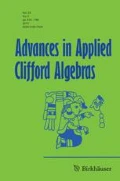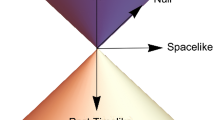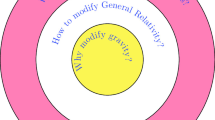Abstract
Does relativistic gravity provide arguments against the existence of a preferred frame? Our answer is negative. We define a viable theory of gravity with preferred frame. In this theory, the EEP holds exactly, and the Einstein equations of GR limit are obtained in a natural limit. Despite some remarkable differences (stable “frozen stars” instead of black holes, a “big bounce” instead of the big bang, exclusion of nontrivial topologies and closed causal loops, and a preference for a flat universe) the theory is viable.
The equations of the theory are derived from simple axioms about some fundamental condensed matter (the generalized Lorentz ether), so that, in particular, the EEP is not postulated but derived.
The theory is compatible with the condensed matter interpretation for the fermions and gauge fields of the standard model.
Similar content being viewed by others
References
Ashtekar A.: New Variables for Classical and Quantum–Gravity. Phys. Rev. Lett 57, 2244–2247 (1986)
Aspect A., Dalibard J., Roger G.: Experimental Test of Bell’s Inequalities Using Time-Varying Analysers. Phys. Rev. Lett 49, 1801–1807 (1982)
Arnowitt R., Deser S., Misner C.: Quantum Theory of Gravitation-General Formulation and Linearized Theory. Phys. Rev 113, 745–750 (1959)
Anderson J.L.: Principles of Relativity Physics. Academic Press, New York (1967)
Barcelo C., Liberati S., Visser M.: Analog Gravity from Field Theory Normal Modes? Class. Quant. Grav 18, 3595–3610 (2001) [arXiv:gr-qc/0104001]
C. Barcelo, S. Liberati, M. Visser, Analogue Gravity. Living Rev. Rel. 8, 12 (2005). [http://www.livingreviews.org/lrr-2005-12] [arXiv:gr-qc/0505065]
Bell J. S.: On the Einstein-Podolsky-Rosen Paradox. Physics 1, 195–200 (1964)
J. S. Bell, in P.C.W. Davies and J.R. Brown. (Eds.), The Ghost in the Atom. Cambridge University Press, Cambridge, 1986, pp. 45–57.
Broer L.F.J., Kobussen J.A.: Conversion from Material to Local Coordinates as a Canonical Transformation. Appl. Sci. Res 29, 419–429 (1974)
Bohm D.: A Suggested Interpretation of Quantum Theory in Terms of Hidden Variables. Phys. Rev 85, 166–179 (1952)
Bohm D., Hiley B.J.: The Undivided Universe: An Ontological Interpretation of Quantum Theory. Routledge, London (1993)
Butterfield J., Isham C. J.: Spacetime and the Philosophical Challenge of Quantum Gravity. In: Callender, C., Huggett, N. (eds) Physics Meets Philosophy at the Planck Scale., pp. 33–89. Cambridge University Press, Cambridge (2000) [arXiv:gr-qc/9903072]
Choquet-Bruhat Y.: Theoreme D’Existence Pour Certain Systemes D’Equations Aux Derivees Partielles Non Lineaires. Acta Math 88, 141–225 (1952)
S. Deser, Gen. Rel. and Grav 1, Self-interaction and Gauge Invariance. 9–18 (1970).
D. Dürr, S. Goldstein, N. Zanghi, Bohmian Mechanics as the Foundation of Quantum Mechanics. In J.T. Cushing, A. Fine, and S. Goldstein (eds.) Bohmian Mechanics and Quantum Theory: An Appraisal, Boston Studies in the Philosophy of Science 184, 21–44 (1996). [arXiv:quant-ph/9511016]
Einstein A., Podolsky B., Rosen N.: Can Quantum-Mechanical Description of Physical Reality Be Considered Complete? Phys. Rev 47, 777–780 (1935)
R. P. Feynman, Lectures on Gravitation. Calif. Inst. of Technol. 1963., Notes prepared by F. B. Morimigo and W; G.Wagner, edited by B. Hatfiled, Addison- Wesley Publ. Co., Reading, MA, 1995.
Fock V.: Theorie von Raum, Zeit und Gravitation. Akademie-Verlag, Berlin (1960)
D. E. Groom et al., 2000 Rev. of Particle Physics, The European Physical Journal C15 (2000) 1, available on the PDG WWW pages (URL:http://pdg.lbl.gov/).
Jacobson T.: Thermodynamics of Spacetime: the Einstein Equation of State. Phys. Rev. Lett 75, 1260–1263 (1965) [arXiv:gr-qc/9504004]
Jacobson T.: Spontaneously Broken Lorentz Symmetry and Gravity. Phys. Rev D, 024028, 024028 (2001) [arXiv:gr-qc/0007031]
Kretschmann E.: Über den Physikalischen Sinn der Relativitätspostulate. A. Einsteins Neue und seine Ursprüngliche Relativitätstheorie. Ann. Phys 53, 575–614 (1917)
Kuchar K.V., Torre C.G.: Harmonic Gauge in Canonical Gravity. Phys. Rev. D 44, 3116–3123 (1991)
LogunovA.A. Loskutov Yu, LogunovA.A. Loskutov Yu: Contradictory Character of General Relativity-The Relativistic Theory of Gravitation. Theor. Math. Phys 67, 425–433 (1986)
A. A. Logunov, Relativistic Theory of Gravity. (In russ.) Nauka, 2006.
Logunov A.A.: The Relativistic Theory of Gravitation and New Notions of Space-Time. Theor. Math. Phys 70, 1–10 (1987)
S. S. Gershtein, A. A. Logunov, M. A. Mestvirishvili, The Upper Limit on the Graviton Mass. [arXiv:hep-th/9711147]
Vlasov A.A., Logunov A.A.: Bouncing From the Schwarzschild Sphere in the Relativistic Theory of Gravitation with Nonzero Graviton Mass. Theor. Math. Phys 78, 229–233 (1989)
Logunov A.A., Mestvirishvili M.A., Chugreev Yu.V.: Graviton Mass and Evolution in a Frideman Universe. Theor. Math. Phys 74, 1–10 (1988)
C. Malyshev, The T(3)-Gauge Model, the Einstein-Like Gauge Equation, and Volterra Dislocations with Modified Asymptotics. Ann. Phys. (NewYork) 286 (2000), 249–247. [arXiv:cond-mat/9901316]
K. Menou, E. Quataert, R. Narayan, Astrophysical Evidence for Blackhole Event Horizons. In N. Dadhich and J. Narlikar, Gravitation and Relativity and Relativity: At the Turn of the Millenium, pp. 43–66, Proceedings of the GR-15 Conference, Inter-University Centre for Astronomy and Astrophysics, Pune, India 1997. [arXiv:gr-qc/9803057]
Misner C., Thorne K., Wheeler J.: Gravitation. Freedman, San Francisco (1973)
Nelson E.: Derivation of the Schroedinger Equation from Newtonian Mechanics. Phys. Rev 150, 1079–1085 (1966)
J. R. Primack, Dark Matter and Structure Formation in the Universe. In A. Dekel and J. P. Ostriker (eds.), Formation of Structures in the Universe, chapter 1, Proceedings of the Jerusalem Winter School 1996, Cambridge University Press, Cambridge, 1999. [arXiv:astro-ph/9707285]
Polchinski J.: String Theory. Cambridge University Press, Cambridge (1998)
Riess A.G. et al.: The Farthest Known Supernova: Support for an Accelerating Universe and a Glimpse of the Epoch of Deceleration. Astrophys. J 560, 49–71 (2001) [arXiv:astro-ph/0104455]
Rosen N.: Flat-Space Metric in General Relativity. Ann. of Phys (New York) 22, 1–11 (1963)
Rosu H.C.: Hawking-like Effects and Unruh-like Effects: Toward Experiments? Grav. Cosmol 7, 1–17 (2001) [arXiv:gr-qc/9406012]
A. D. Sakharov, Vacuum Quantum Fluctuations in Curved Space and the Theory of Gravitation. Sov. Phys. Doklady 12 (1968), 1040–1041; Reprinted in Gen. Rel. Grav. 32 (2000), 365–366.
I. Schmelzer, General Ether Theory – A Metric Theory of Gravity with Condensed Matter Interpretation. Proc. of the XXII International Workshop on High Energy Physics and Field theory. Protvino, June 1999, 23–25.
Schmelzer I.: A Condensed Matter Interpretation of SM Fermions and Gauge Fields. Found. Phys 39, 73–107 (2009) [arXiv:0908.0591]
Unruh W.G.: Experimental Black-Hole Evaporation. Phys. Rev Lett 46, 1351–1353 (1981)
M. Visser, Acoustic Black Holes: Horizons, Ergospheres, and Hawking Radiation. Class.Quant.Grav. 15 (1998), 1767–179. [arXiv:gr-qc/9712010]
Volovik G.E.: Induced Gravity in Superfluid 3He. J. Low. Temp. Phys 113, 667–680 (1998) [arXiv:cond-mat/9806010]
Volovik G. E.: Field theory in Superfluid 3He: What are the lessons for particle physics, gravity and high-temperature superconductivity? Proc. Nat. Acad. Sci 96, 6042–6047 (1999) [arXiv:cond-mat/9812381]
H.-J. Wagner, Das inverse Problem der Lagrangeschen Feldtheorie in Hydrodynamik, Plasmaphysik und hydrodynamischem Bild der Quantenmechanik. Universit ät Paderborn, 1997.
Weinberg S.: Photons and Gravitons in Perturbation Theory-Derivation of Maxwell and Einstein Equations. Phys. Rev 138, 988–1002 (1965)
S. Weinberg, What is Quantum Field Theory, and What Did We Think It Is? [arXiv:hep-th/9702027]
C.M. Will, The Confrontation Between General Relativity and Experiment. [arXiv:gr-qc/9811036]
Woit P.: Not Even Wrong. Jonathan Cape, London (2006)
Author information
Authors and Affiliations
Corresponding author
Rights and permissions
About this article
Cite this article
Schmelzer, I. A Generalization of the Lorentz Ether to Gravity with General-Relativistic Limit. Adv. Appl. Clifford Algebras 22, 203–242 (2012). https://doi.org/10.1007/s00006-011-0303-7
Received:
Accepted:
Published:
Issue Date:
DOI: https://doi.org/10.1007/s00006-011-0303-7




